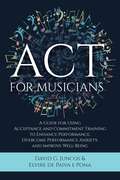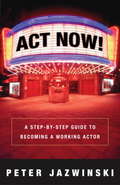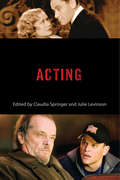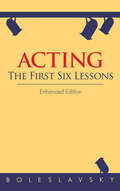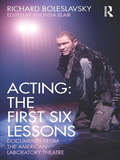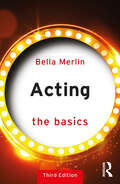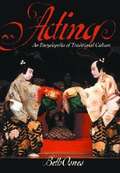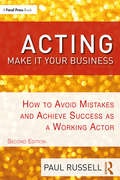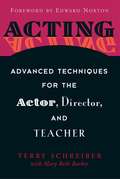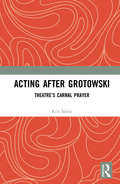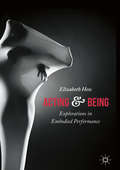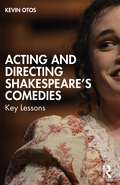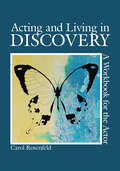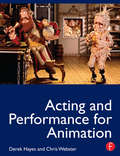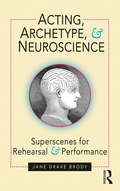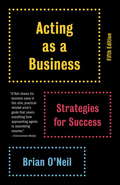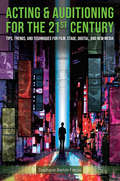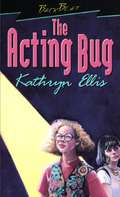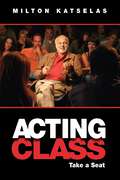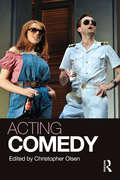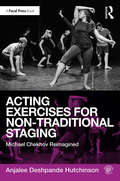- Table View
- List View
ACT for Musicians: A Guide for Using Acceptance and Commitment Training to Enhance Performance, Overcome Performance Anxiety, and Improve Well-Being
by David G. JuncosWhile it is widely recognized that music contributes to the health and well-being of societies, the reverse is not necessarily true. Being a professional musician is a rewarding yet challenging occupation, and the results of newer survey studies show musi
Act Now! A Step-by-step Guide to Becoming a Working Actor
by Peter JazwinskiSo, you want to be an actor . . . but you have no idea how to get started. In the pages of Act Now!, you'll find a step-by-step process to show you not only how to get started, but also how to become a working actor. It will take time and commitment, but if you follow these steps you will find success. Author and acting teacher Peter Jazwinski explains every aspect of becoming an actor from start to finish. You'll learn about: * Improving Your Acting Skills * How Actors Get Cast * Finding Auditions on Your Own * Working with an Agent or Manager--and What the Difference Is * The Importance of Networking * And More! A frank and encouraging game plan for success,Act Now!will empower those who have the drive to stop dreaming and start making a living--as an actor.
Act of God
by Margaret KennedySculptor Conrad Swann mysteriously disappears, and his self-appointed patron Martha Rawson takes it upon herself to promote his latest work. Although nearly everyone finds the piece hideous, Martha persuades the town council of East Head to purchase it. The townspeople struggle to accept it as a piece of modern art. Controversy over the sculpture reveals deep cracks in the marriage of Dickie and Christina Pattison. This novel presents a gallery of well-drawn characters and portrays life in a postwar English village with gentle bemusement.
Acting
by Cynthia Baron David Sterritt Claudia Springer Arthur Nolletti Jr. Donna Peberdy Julie Levinson Victoria DuckettScreen performances entertain and delight us but we rarely stop to consider actors' reliance on their craft to create memorable characters. Although film acting may appear effortless, a host of techniques, artistic conventions, and social factors shape the construction of each role. The chapters in Acting provide a fascinating, in-depth look at the history of film acting, from its inception in 1895 when spectators thrilled at the sight of vaudeville performers, Wild West stars, and athletes captured in motion, to the present when audiences marvel at the seamless blend of human actors with CGI. Experts in the field take readers behind the silver screen to learn about the craft of film acting in six eras: the silent screen (1895-1928), classical Hollywood (1928-1946), postwar Hollywood (1947-1967), the auteur renaissance (1968-1980), the New Hollywood (1981-1999), and the modern entertainment marketplace (2000-present). The contributors pay special attention to definitive performances by notable film stars, including Lillian Gish, Dick Powell, Ginger Rogers, Beulah Bondi, Marilyn Monroe, Marlon Brando, Jack Nicholson, Robert De Niro, Nicholas Cage, Denzel Washington, and Andy Serkis. In six original essays, the contributors to this volume illuminate the dynamic role of acting in the creation and evolving practices of the American film industry. Acting is a volume in the Behind the Silver Screen series--other titles in the series include Animation; Art Direction and Production Design; Cinematography; Costume, Makeup, and Hair; Directing; Editing and Special/Visual Effects; Producing; Screenwriting; and Sound.
Acting: Onstage and Off (5th edition)
by Robert BartonDemonstrating how offstage performance can be effectively adapted for the theatre, as well as how onstage training can be applied toward leading a full life outside the theatre. ACTING: ONSTAGE AND OFF is a humorous yet informative book that discusses the interplay between life on and off the stage.
Acting: The First Six Lessons
by Richard BoleslavskyThe classic text on the craft of Method acting by the founder of The American Laboratory Theatre.After studying at the Moscow Art Theatre under Konstantin Stanislavski, Richard Boleslavsky became one of the most important acting teachers of his or any generation. Bringing Stanislavski&’s system to America in the 1920s and 30s, he influenced many of the titans of American drama, from his own students—including Lee Strasburg and Stella Adler—to Marlon Brando, Paul Newman, and many others.In Acting: The First Six Lessons, Boleslavsky presents his acting theory and technique in a series of accessible and engaging dialogues. Widely considered a must-have for any serious actor, Boleslavsky&’s work has long helped actors better understand their craft.
Acting: Documents from the American Laboratory Theatre
by Richard Boleslavsky Rhonda BlairActing: The First Six Lessons was first published in 1933 and remains a key text for anyone studying acting today. These dramatic dialogues between teacher and idealistic student explore the field of acting according to one of the original teachers of Stanislavsky’s System in America. <p><p> This new edition of an essential text is edited by Rhonda Blair and supplemented for the very first time with documents from the American Laboratory Theatre. These collect together a broad range of exciting unpublished material, drawn from Boleslavsky’s pivotal and unprecedented teachings on acting at the American Laboratory Theatre.
Acting: The Basics (The Basics)
by Bella MerlinActing: The Basics 3rd Edition is a dynamic response to recent societal and entertainment industry changes, focusing on inclusion, diversity and equity, and the actor's trajectory from training to rehearsal to performance on stage and screen, with hands-on tools and global perspectives. The book offers vital ways of building a practical acting toolkit, through breath, body, voice, emotions, imagination and spirit. We begin with a socio-cultural look at actor as magician, storyteller, healer and social changer. Throughout, there are insights from Black, Indigenous, First Nations, South/East Asian, intercultural and feminist practitioners, together with methods focusing on disability and accessibility, intimacy directives, mindfulness and intersectionality. Key 'canonical' figures still feature (e.g., Stanislavsky, Meisner, Brecht and Suzuki) with re-visioned perspective. Scattered throughout are post-COVID insights, plus expanded sections on screen acting (including self-tapes) and Shakespeare. This book is useful for beginner or expert, as it's always helpful getting back to basics. Because the author is both an actor and an actor trainer, the tools are steeped in user-friendly application. At the same time, transferable skills (e.g., dynamic listening and empathy) are shown as relevant to everyone. With a glossary of terms and useful online suggestions (including blogs, videos and podcasts), this is ideal for anyone learn anew about the practice and history of acting, or to take their acting and teaching into new terrain.
Acting: An International Encyclopedia
by Beth OsnesExpanding beyond the conventional western concept of theater, the reference explores current and historical rituals, festivals, and performances from countries and cultures around the world; contributions of women to acting and the performing arts; and cinema and the film industry. The cross-referencing is extensive, and entry-specific references augment the general bibliography.
Acting: How to Avoid Mistakes and Achieve Success as a Working Actor
by Paul RussellIn ACTING: Make It Your Business, Second Edition, award-winning casting director Paul Russell puts the power to land jobs and thrive in any medium—stage, film, television, or the Internet—directly into the hands of the actor. This blunt and practical guide offers a wealth of advice on auditioning, marketing, and networking, combining traditional techniques with those best suited for the digital age. Well-known actors and powerful agents and managers make cameos throughout, offering newcomers and working professionals alike a clear-eyed, uncensored perspective on survival and advancement within the entertainment industry. This second edition has been updated and expanded to include the following: More stars of screen and stage sharing acting career strategies Digital audition techniques for screen and stage, including how best to self-tape New tools to master modern marketing, both digital and traditional with innovation Expanded actor resource listings Additional bicoastal talent agents and managers spilling secrets for obtaining representation, and tips for successful actor-to-representation partnerships New insights on audition techniques An excellent resource for career actors, beginning and amateur actors, as well as students in Acting I and II, Auditions, and Business of Acting courses, ACTING: Make It Your Business provides readers with invaluable tools to build a successful, long-lasting acting career.
Acting: Advanced Techniques for the Actor, Director, and Teacher
by Terry Schreiber Mary Beth Barber Edward NortonHoned by the author's 35 years of teaching, this advanced book offers different warm-up exercises concentrating on the actor's sense of smell, sound, sight, and touch; sensory tools for conveying the climate and environment of the text; tips for suggesting a character's physical conditions; and much more. Individual exercises will help actors to free the voice and body, create a character, find the action and condition of scenes, and explore the subconscious for effective emotional recall. Readers will also find meticulous guidelines for best using rehearsal time and preparing for in-class scene work. The foreword is written by two-time Academy Award nominee Edward Norton. Those who act, direct, or teach will not want to miss the acting lessons that have made T. Schreiber Studio a premier actor training program.
Acting after Grotowski: Theatre’s Carnal Prayer
by Kris SalataFor whom does the actor perform? To answer this foundational question of the actor’s art, Grotowski scholar Kris Salata explores acting as a self-revelatory action, introduces Grotowski’s concept of "carnal prayer," and develops an interdisciplinary theory of acting and spectating. Acting after Grotowski: Theatre’s Carnal Prayer attempts to overcome the religious/secular binary by treating "prayer" as a pre-religious, originary deed, and ultimately situates theatre along with ritual in their shared territory of play. Grounded in theatre practice, Salata’s narrative moves through postmodern philosophy, critical theory, theatre, performance, ritual, and religious studies, concluding that the fundamental structure of prayer, which underpins the actor’s deed, can be found in any self-revelatory creative act.
Acting and Being: Explorations in Embodied Performance
by Elizabeth HessIn this book, educator-actor-playwright-director Elizabeth Hess offers systematic and original explorations in performance technique. This hybrid approach is a fusion of physical theater modalities culled from Western practices (Psycho-physical actions, Viewpoints) Eastern practices (Butoh, Kundalini yoga) and related performance disciplines (Mask, Puppetry). Behavioral, physiological and psychological 'states of being' are engaged to unlock impulses, access experience and enlarge the imagination. Through individual, partnered and collective explorations, actors uncover a character's essence and level of consciousness, their energy center and body language, and their archetype and relationship to universal themes. Magic (to pretend, as if), Metaphor (to compare, as like) and Myth (to pattern after, as in) provide the foundation for generating transformative, empathetic and expansive artistic expression. Explorations can be adapted to character work, scene study and production, including original/devised work and established text, to illuminate singular and surprising work through collaborative creativity that is inventive, inclusive and alive.
Acting and Directing Shakespeare's Comedies: Key Lessons
by Kevin OtosActing and Directing Shakespeare’s Comedies: Key Lessons outlines a clear, effective process for acting Shakespeare’s comedies. This book lays out core principles and useful exercises that help the reader better understand, expereince, and implement Shakespeare's comedic design. Building off of modern acting methods as well as contemporary Clown, classical Commedia, and verse-speaking techniques, the author guides the reader toward interpretive and performance choices that are original, justified, and entertaining. Included are clear examples and detailed case studies that illuminate and reenforce these key lessons. This accessible book is for actors, directors, students of Shakespeare, and those who want a fuller, richer awareness of the possibilities within Shakespeare’s comedies and a clear, pragmatic process for creating those performances.
Acting and Living in Discovery: A Workbook for the Actor
by Carol RosenfeldActing and Living in Discovery, A Workbook for the Actor lays out essential fundamentals of the actor’s process. Based on the author’s experiences at the legendary HB Studio in New York City, Acting and Living in Discovery provides practical guidance for developing, honing, or revitalizing the actor’s craft for the actor. A teacher can use the workbook to support a studio class, a special workshop, part of a university acting course, or private coaching. The chapters delve into basic facets of the acting process that lead the actor into discovering the corporal world of a script. Exercises at the end of each chapter invite the actor to discover the treasure trove of his unique self, and spell out the work an actor can do to wear the shoes of any character. The actor is at once the instrument and the player. The workbook can be read straight through or used as a reference for addressing a particular problem or topic.
Acting and Performance for Animation
by Derek HayesCharacter animation involves more than the principles of animation and the mechanics of motion. Unique, believeable characters that think, feel and captivate your audience are ones that involve emotion, performance, personality, acting and story. Successful animators balance all of these elements within a single character and narrative. With Acting and Performance for Animation, discover how to create dynamic, dramatic performances and believeable character interaction. An invaluable resource for animators, Acting and Performance for Animators is a practical guide to the variety of performance techniques relevant to animators. Develop believable character interactions with chapters detailing the principles of performance, performance types, character emotion and personality, physical and psychological performance, and scene composition. Analyze scripts, sound,acting, action and performance with the practical hints and tips, hands-on assignments and animated examples featured in an extensive guide for animators working in film, TV, games and commercials. Explore different performance techniques based upon the experiences of seasoned animators with case studies featuring John Lasseter, Ray Harryhausen, Nick Park, Joanna Quinn. Expand your own performance techniques with the accompanying DVD which will feature live action reference shorts, production stills, animated examples, and further hands-on assignments.
Acting, Archetype, and Neuroscience: Superscenes for Rehearsal and Performance
by Jane Drake Brody"How do we move actors into the less accessible regions of themselves and release hotter, more dangerous, and less literal means of approaching a role?" Superscenes are a revolutionary new mode of teaching and rehearsal, allowing the actor to discover and utilize the primal energies underlying dramatic texts. In Acting, Archetype, and Neuroscience Jane Drake Brody draws upon a lifetime’s experience in the theatre, alongside the best insights into pedagogical practice in the field, the work of philosophers and writers who have focused on myth and archetype, and the latest insights of neuroscience. The resulting interdisciplinary, exciting volume works to: Mine the essentials of accepted acting theory while finding ways to access more primally-based human behavior in actors Restore a focus on storytelling that has been lost in the rush to create complex characters with arresting physical and vocal lives Uncover the mythical bones buried within every piece of dramatic writing; the skeletal framework upon which hangs the language and drama of the play itself Focus on the actor’s body as the only place where the conflict inherent in drama can be animated. Acting, Archetype, and Neuroscience weaves together a wealth of seemingly disparate performance methods, exciting actors to imaginatively and playfully take risks they might otherwise avoid. A radical new mixture of theory and practice by a highly respected teacher of acting, this volume is a must-read for students and performance practitioners alike.
Acting as a Business
by Brian O'NeilAn essential handbook for actors–a modern classic–in a newly updated edition.Since its original publication, Acting as a Business has earned a reputation as an indispensable tool for working and aspiring actors. Avoiding the usual advice about persistence and luck, Brian O’Neil provides clear-cut guidelines that will give actors a solid knowledge of the business behind their art. It’s packed with practical information–on everything from what to say in a cover letter to where to stand when performing in agent’s office–including:•How to craft a winning theatrical résumé•The most effective ways to join the performer’s unions•Tactics for getting an agent•Strategies for finding work in the theater, on daytime television, and in independent films•Navigating the different customs and cultures of New York and Los AngelesO’Neil has updated Acting as a Business to keep up with the latest show-business trends, including how best to use the Internet, making this new edition no actor should be without.
Acting & Auditioning for the 21st Century: Tips, Trends, and Techniques for Digital and New Media
by Stephanie Barton-FarcasActing & Auditioning for the 21st Century covers acting and auditioning in relation to new media, blue and green screen technology, motion capture, web series, audiobook work, evolving livestreamed web series, and international acting and audio work. Readers are given a methodology for changing artistic technology and the global acting market, with chapters covering auditions of all kinds, contracts, the impact of new technology and issues relating to disabled actors, actors of colour and actors that are part of the LGBTQIA community.
The Acting Bug
by Kathryn EllisTV stardom – fame, fortune, and Hollywood! It’s the chance of a lifetime for Kate Merriman when she lands a small role in a new TV series called Backbeat. But it’s less fun when Kate finds out her best friend Maria has turned down the part she’s been offered in the show. They’re always there for each other. How can Kate succeed when Maria’s not there to share this new adventure. And why doesn’t their friendship seem to work any more? In her first novel in the Backbeat series, Kathryn Ellis provides a lively look into the world of TV shows – and close friendships.
Acting Class: Take a Seat
by Milton KatselasJim Carrey, Kyle Chandler, George Clooney, Ted Danson, Kate Hudson, Justina Machado, Michelle Pfeiffer, and Tom Selleck are just some of the many celebrated actors who have benefited from the legendary acting teacher Milton Katselas. As the founder of the prestigious Beverly Hills Playhouse, Katselas was regarded by many as one of America's foremost acting teachers as well as an acclaimed director. Originally available only to students at the Beverly Hills Playhouse, Acting Class: Take a Seat presents the concepts and methods that helped lead a generation of actors to success on stage, in cinema, and on television. In this all-encompassing book, Katselas invites readers to “sit in” on the classes he taught for more than forty years. Acting Class covers in detail three concepts central to the Katselas approach: Acting, Attitude, and Administration. Katselas not only covers techniques and methods, but also includes valuable discussions on the attitudes any artist needs to fulfill their dreams.
Acting Comedy
by Christopher OlsenDespite being roundly cited as much harder to perform than its dramatic counterpart, comic acting is traditionally seen as a performance genre that can’t be taught. At best it is often described as a skill that can only be learned "on the job" through years of practice, or given to a performer through natural talent. Acting Comedy is an effort to examine this idea more rigorously by looking at different aspects of the comic actor’s craft. Each chapter is written by an expert in a particular form—from actors and directors to teachers and standup comedians. Topics covered include: how performers work with audiences how comic texts can be enhanced through word and musical rhythm analysis how physical movements can generate comic moments and build character. This book is an invaluable resource for any performer focusing on the minute details of comic acting, even down to exactly how one delivers a joke on stage. Christopher Olsen’s unique collection of comic voices will prove essential reading for students and professionals alike.
Acting Exercises for Non-Traditional Staging: Michael Chekhov Reimagined
by Anjalee Deshpande HutchinsonActing Exercises for Non-Traditional Staging: Michael Chekhov Reimagined offers a new set of exercises for coaching actors when working on productions that are non-traditionally staged in arenas, thrusts, or alleys. All of the exercises are adapted from Michael Chekhov's acting technique, but are reimagined in new and creative ways that offer innovative twists for the practitioner familiar with Chekhov, and easy accessibility for the practitioner new to Chekhov. Exploring the methodology through a modern day lens, these exercises are energizing additions to the classroom and essential tools for more a vibrant rehearsal and performance.
Acting: The First Six Lessons
by Richard BoleslavskyActing: The First Six Lessons by Richard Boleslavsky is a classic and enduring guide to the art of acting, offering both aspiring and seasoned performers a deep understanding of the craft. Originally published in 1933, this book is structured as a series of dialogues between a young actress and an experienced director, through which Boleslavsky imparts essential lessons about technique, emotion, and artistic truth.The six lessons—Concentration, Memory of Emotion, Dramatic Action, Characterization, Observation, and Rhythm—form the foundation of Boleslavsky’s method, drawing from his experience in the Moscow Art Theatre and his study under Konstantin Stanislavski. Each lesson encourages actors to engage both mind and body, teaching them how to tap into personal emotions, create authentic characters, and bring nuance to their performances.Through vivid storytelling and insightful examples, Boleslavsky emphasizes the importance of discipline, empathy, and preparation in the actor’s journey. His conversational approach makes complex techniques accessible, guiding readers to explore their inner world, connect with their characters, and fully inhabit the roles they play. While deeply practical, the book also touches on the philosophical aspects of performance, encouraging actors to view their work as both a craft and a form of personal expression.Acting: The First Six Lessons remains a vital resource for actors, directors, and theater enthusiasts, offering timeless wisdom that continues to shape modern acting methods. Boleslavsky’s blend of technical instruction and artistic inspiration makes this book an essential addition to any actor’s library, challenging performers to approach their work with authenticity, emotional depth, and an unwavering commitment to truth.
Acting for Animators
by Ed HooksEd Hooks' indispensable acting guidebook for animators has been fully updated and improved! Hooks uses basic acting theory to explain everything from character movement and facial expressions to interaction and scene construction. Just as acting on film and on stage are very different disciplines, so is the use of acting theory in creating an animated character, scene or story. Acting for Animators is full of essential craft tips from an acting master. New to this Routledge edition: - scene-by-scene analyses of six films, including Up, Coraline and Kung Fu Panda - an expanded chapter on video game animation - all-new illustrations - a 500 word history of acting
